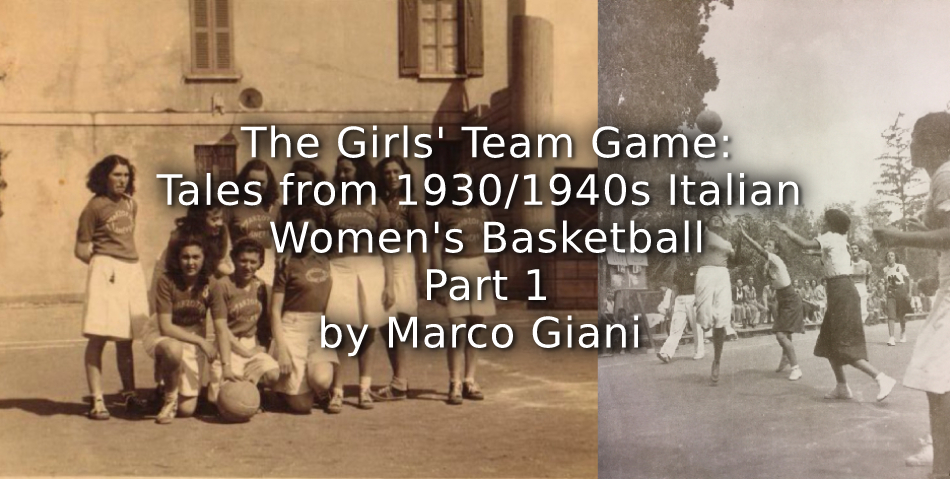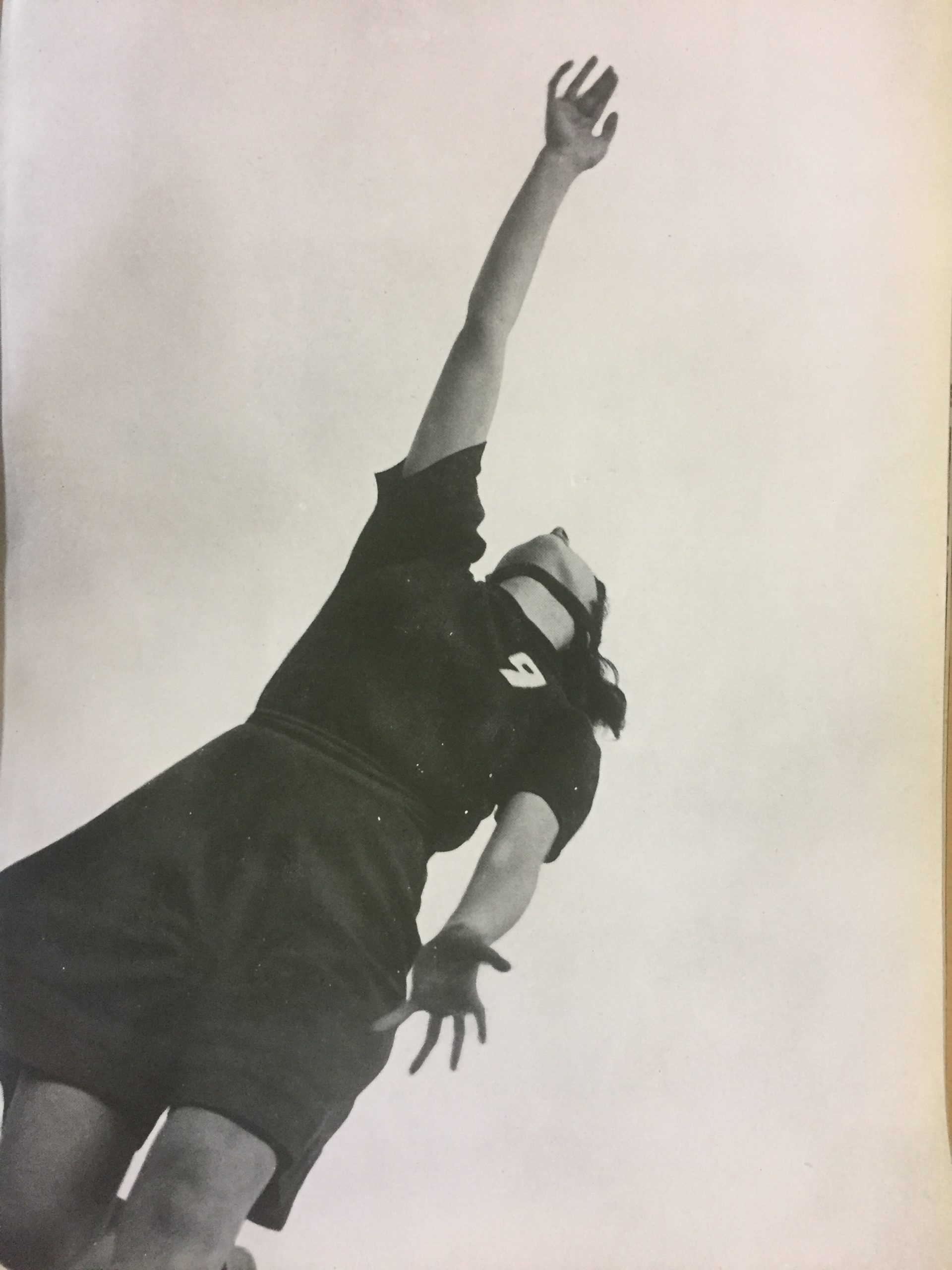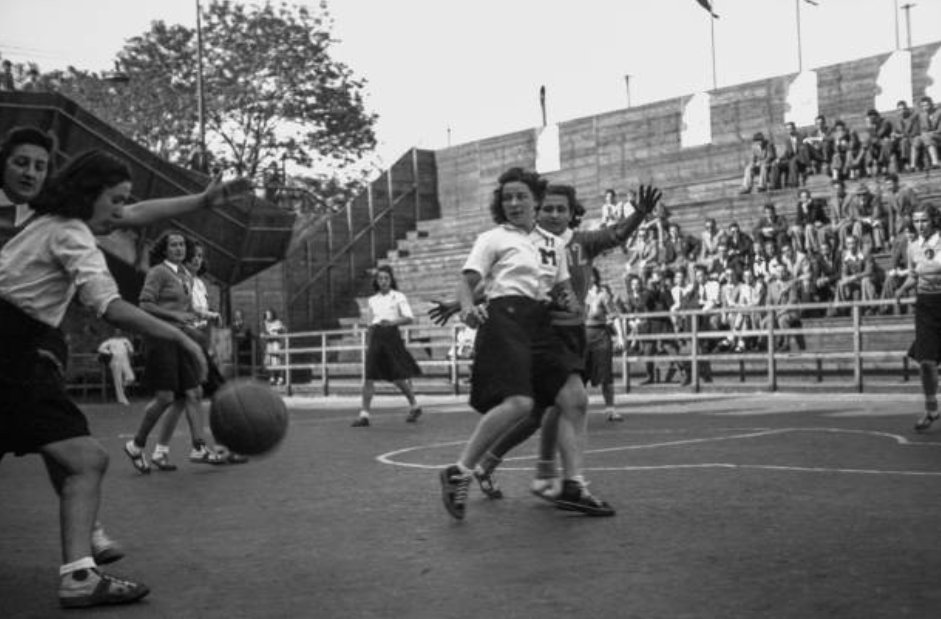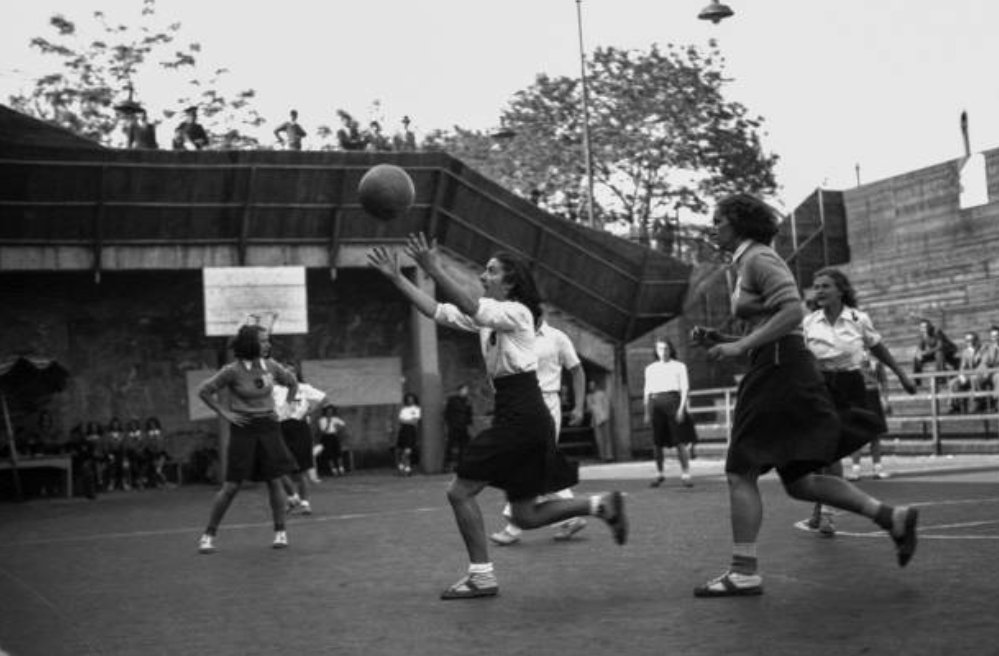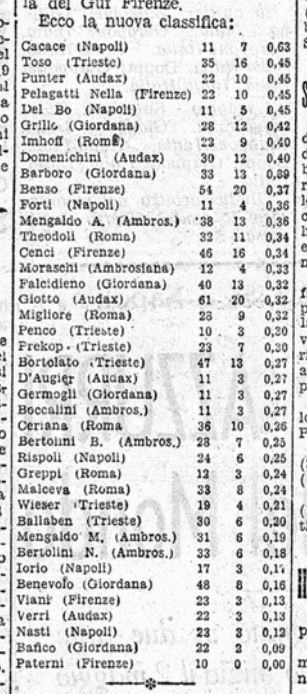Sports History always gives us a different view of our present society. Nowadays in Italy volleyball is no doubt the more practiced team sport among young women, just as – in a strict gendered separation that has only started to ‘fall down’ in recent years – football remains the favoured game for young men.
In interwar Italy volleyball was quite an unknown sport, and not only for women, only a few female and male teams played this strange game imported by American troops during the latter stages of WW1. During the Fascist Ventennio (1922-1943), basketball established itself as the team game for young females.
- Source: Annuario XVII della GIL (1939).
- Source: Annuario XVII della GIL (1939).
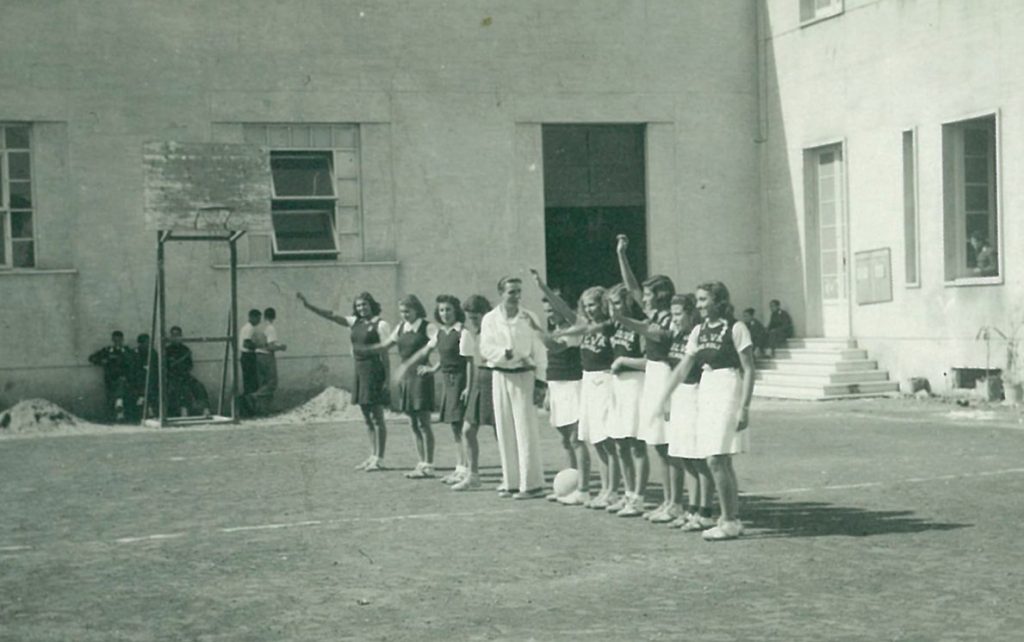
The ritual Roman salute made by the players (GIL Stabia vs. ILVA Bagnoli) before the beginning of the match
Source: https://bit.ly/2WLB2YD
As previously explained in Part 2 of “All About That Skirt” Series (see https://www.playingpasts.co.uk/articles/gender-and-sport/all-about-that-skirt-womens-sportswear-in-1920-1940s-fascist-italy-part-2/ ), the beginning of the 1930s decade was marked by the passage of wearing shorts to wearing skirts. More deeply, there was another bigger change: the pioneering 1920s Italian women’s basketball was still a small movement, led by few private clubs and ruled by FIAF, a women’s-only athletics and basketball national federation; in the early 1930s, the (male) National Basketball Federation, Federazione Italiana Pallacanestro (FIP), got hold of the female movement, and the Fascist regime started to promote basketball among Italian girls, using school programs and the several youth associations such as Piccole Italiane (6-14 years school students), Giovani Italiane (14-18 years high school students), Gruppi Universitari Fascisti (GUF) (university students), Giovani Fasciste (18-22 young workers) and dopolavoriste (older female workers, ruled by Opera Nazionale Dopolavoro, OND).
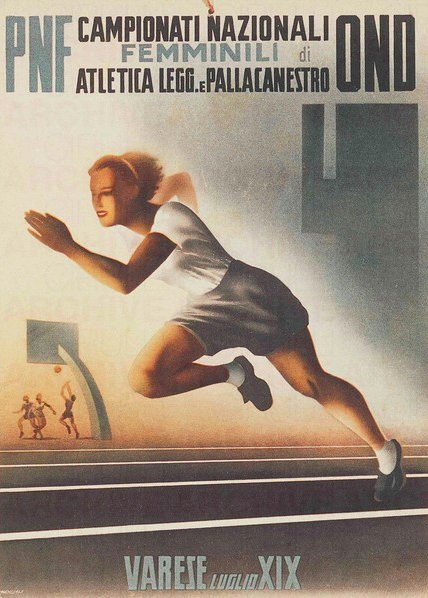
The poster of National Athletics and Basktball Championship, organized by OND in Varese (July 1941)
Source: goo.gl/images/ZVyvwL
-
A women’s match played in Genua (May 1940)
Source: goo.gl/59xCxu
-
A women’s match played in Genua (May 1940). On the bottom, some reserves sitting on the bench
Source: goo.gl/zsBmLa .
Thanks to this double support, in just one decade the women’s basketball movement was able to reach a lot of Italian girls, even outside of the great Northern cities of the 1920s such as Turin, Milan, Trieste and Bologna:
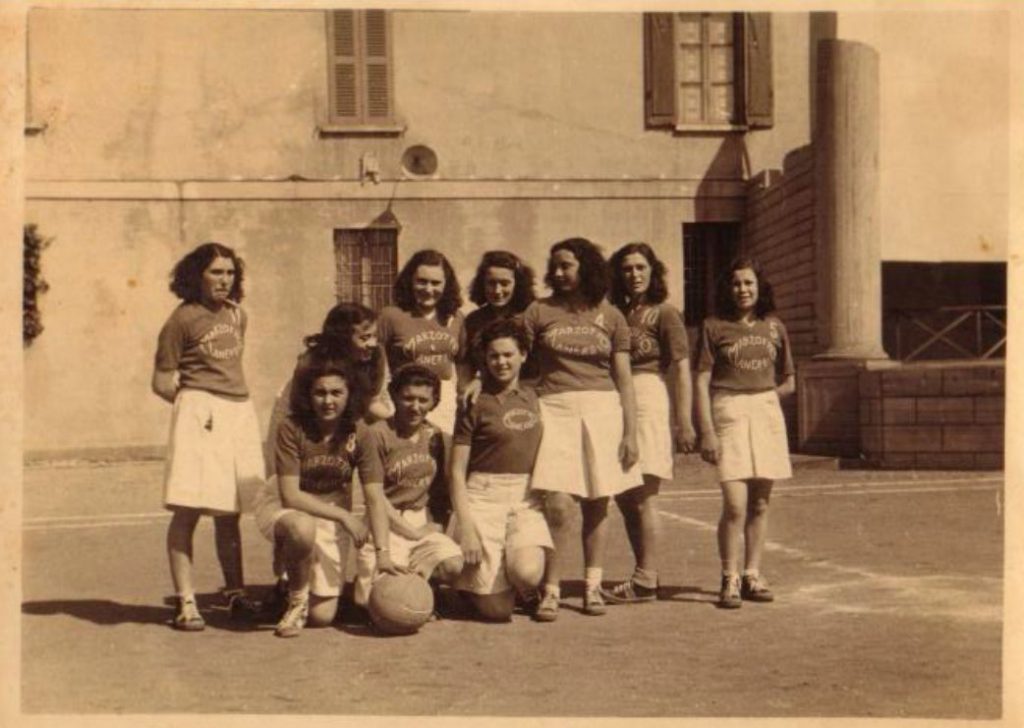
The Marzotto team from Manerbio, Brescia
Marzotto was a company located in the 9,000 inhabitants town of Manerbio so these playes might be dopolavoriste (workers)
Source: goo.gl/66UXiG
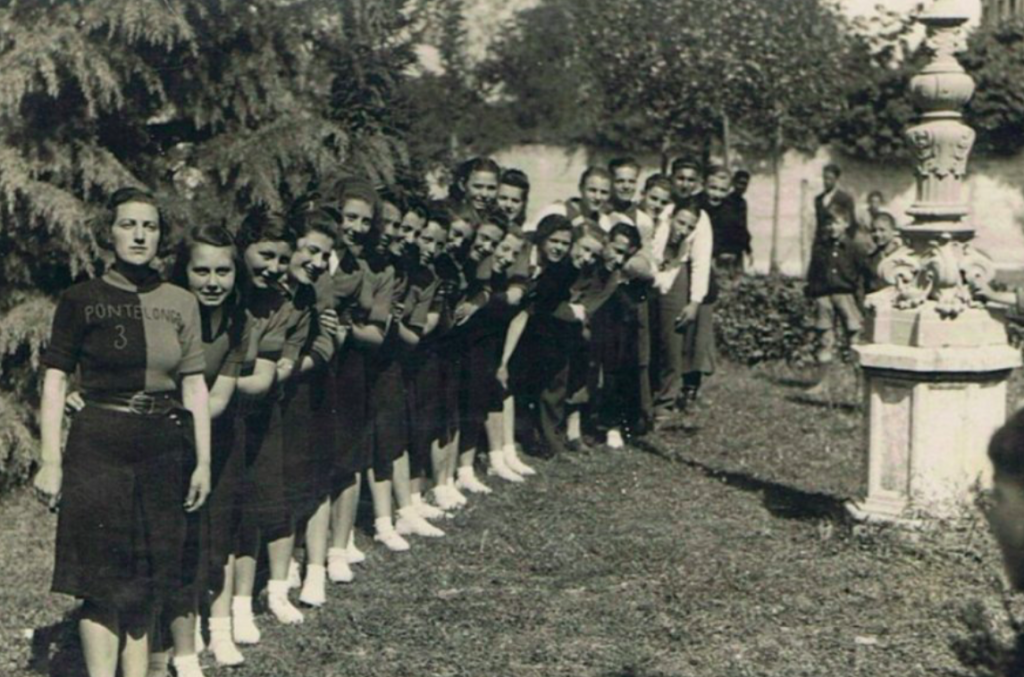
The women’s GIL team from Pontelongo (Padua) pose alongside the male GIL from Piove di Sacco
Source: https://goo.gl/wrzH9v .
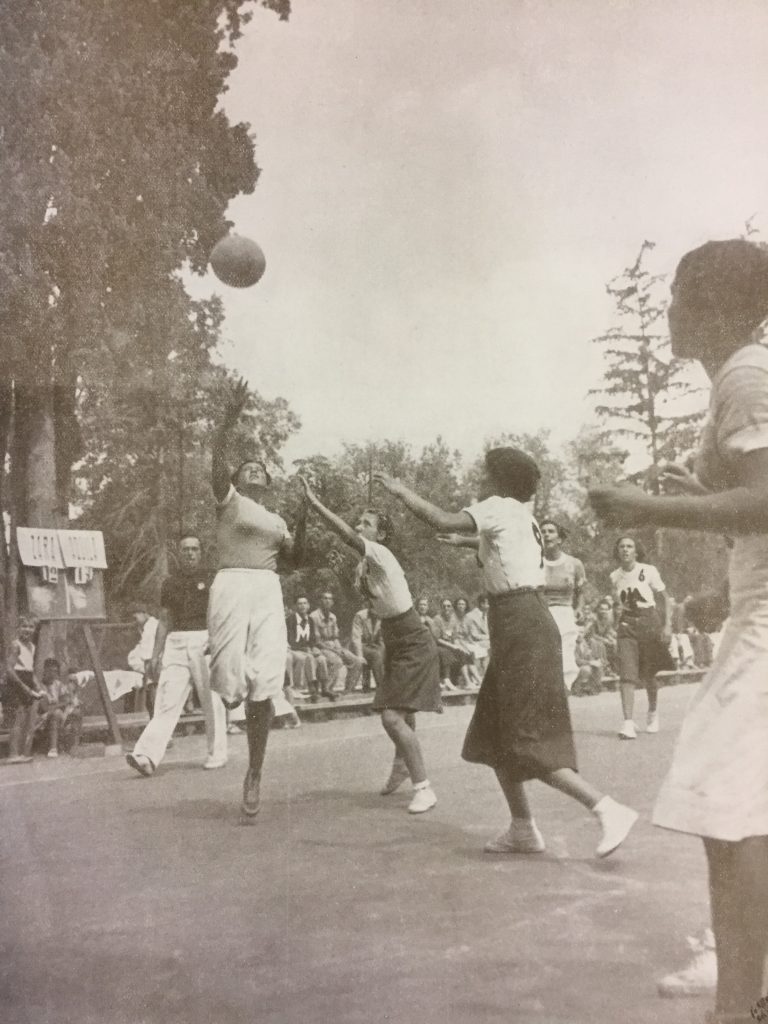
A match between the Zara (today Zadar, in Croatia) and the L’Aquila (Abruzzo) team
During the GIL National Championship, teams from all over Italy played together.
Source: Annuario XVII della GIL (1939).
Above all, basketball reached Southern Italy, one-third of the country where – except for Naples – previously females had had little chance to practice sport, mainly due to the strong conservativism of their families.
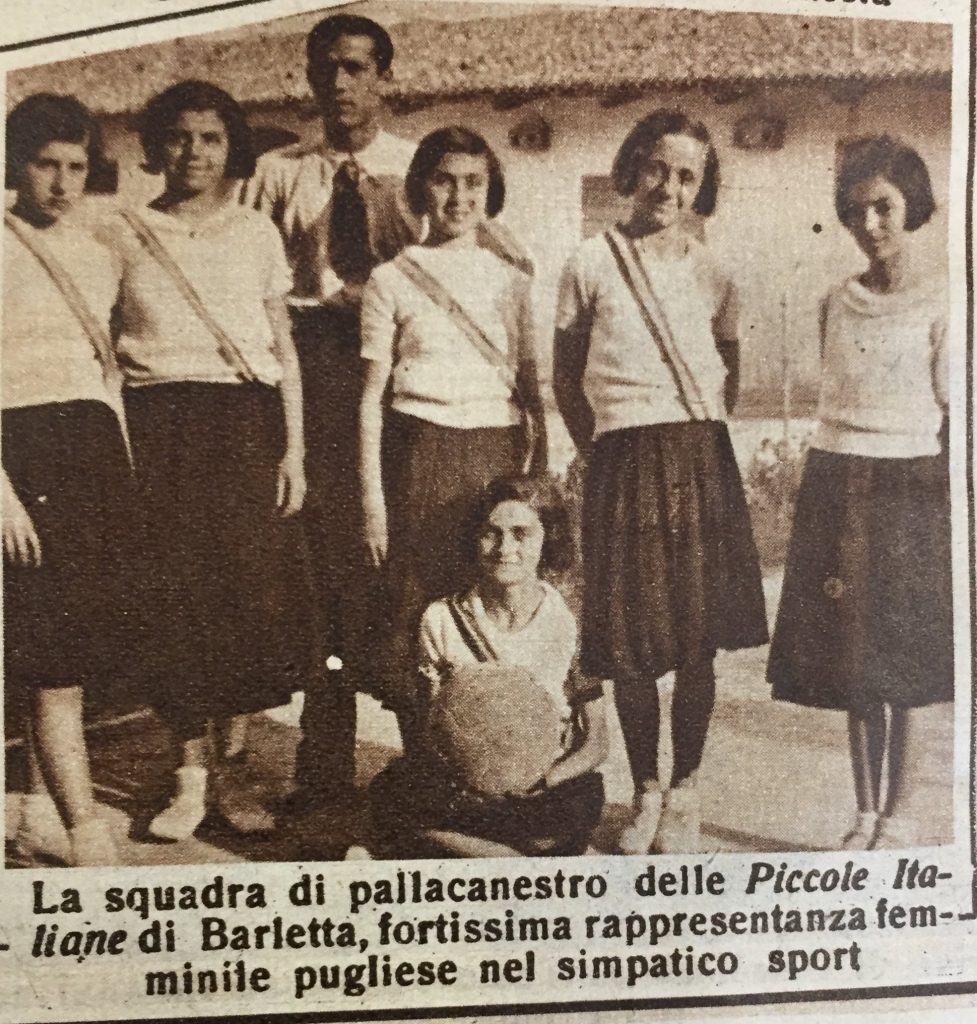
The Piccole Italiane basketball team from Barletta (Apulia) (1933)
Source: Tutti Gli Sports, 02/07/1933, p. 10.
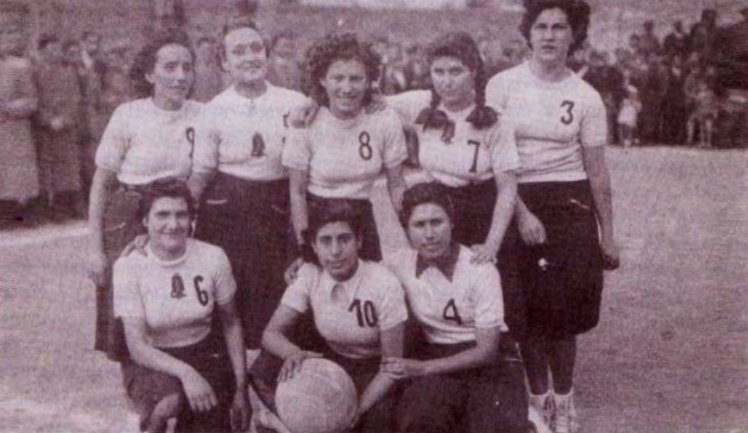
The Reggio Calabria GIL team (1934, or 1937)
Source: goo.gl/Jp4U46
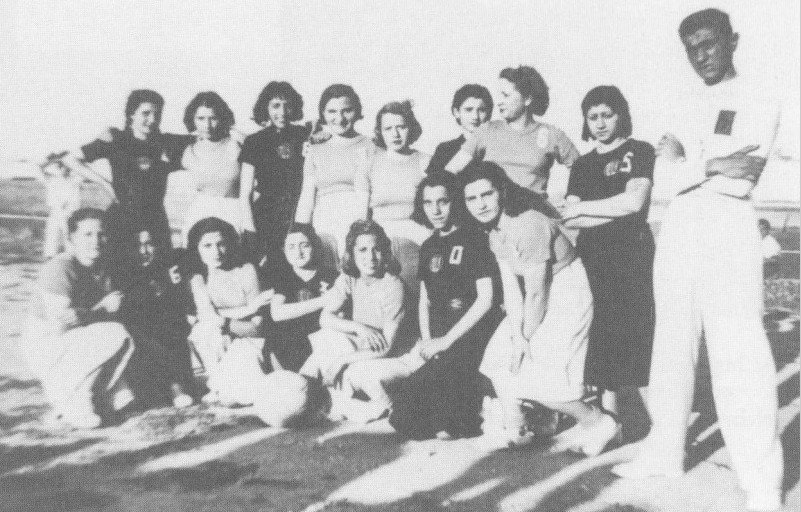
The GIL team from Mola (Bari) (1935, or 1937)
Source: goo.gl/SsrVYv
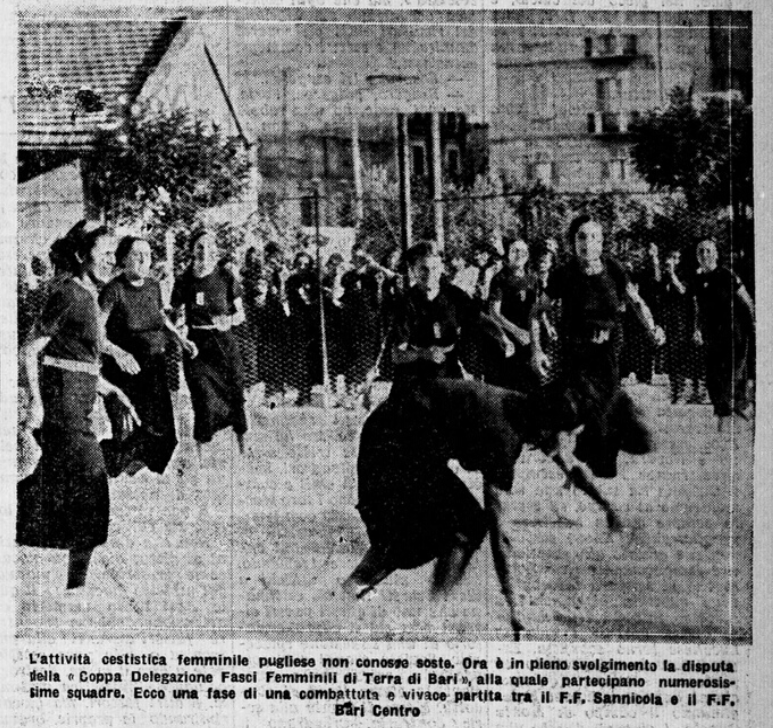
Giovani Fasciste playing during a local tournament organized by Terra di Bari Fascist Federation
Source: Il Littoriale, 17/12/1935, p. 3.
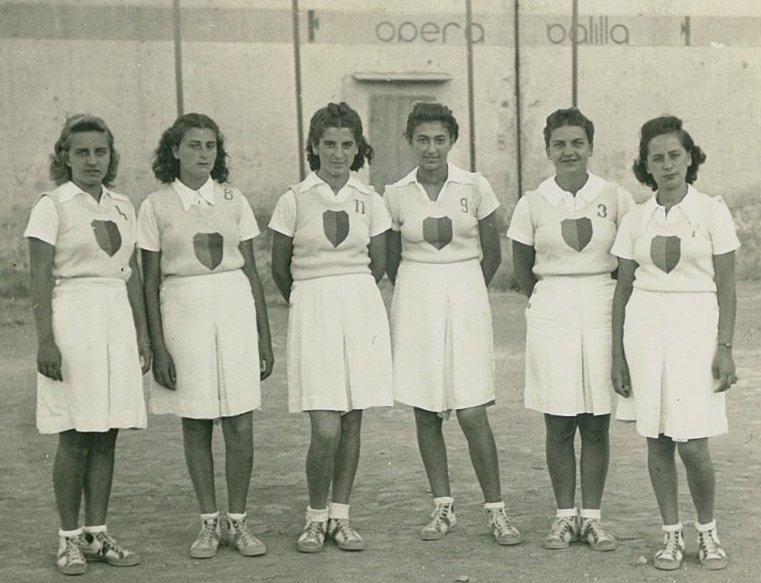
Players from Castellammare di Stabia (Naples) (1938)
Source: https://bit.ly/2WLB2YD .
Basketball even spread out to the Italian colonies such as Eritrea and Ethiopia, although it started late, with few players and – above all – was only for Italian-born females, according to the apartheid-like laws of Italian East Africa.

The clipping says the (male) GUF club in Asmara was launched in 1938; then, in September 1939, some female university students asked for a women’s section, which provided not only basketball, but also horse-riding, language, musical instrument and choral courses
Source: Gli Annali dell’Africa Italiana, III, vol. 1 (1940), p. 916.
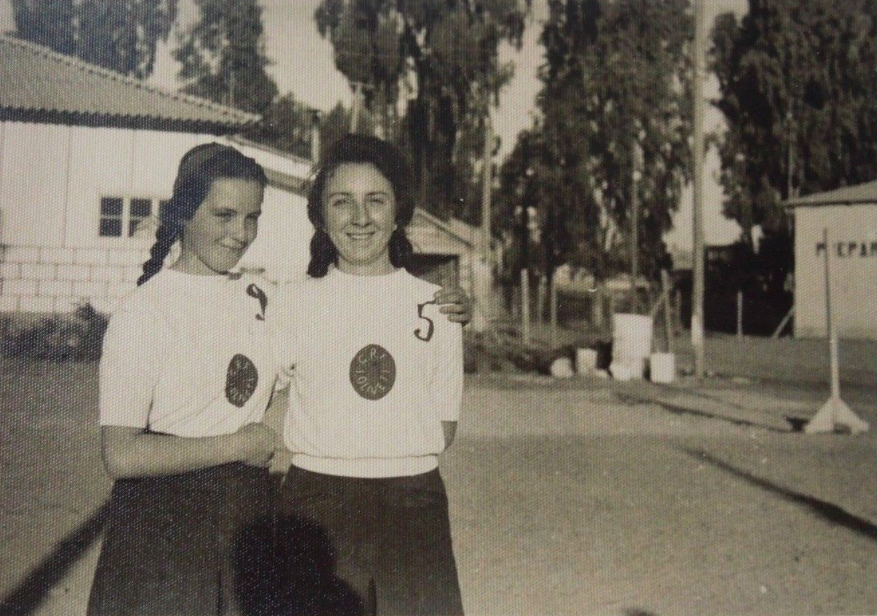
Two Italian players in Asmara (1939)
Source: https://twitter.com/calciatrici1933/status/1138040629500551168
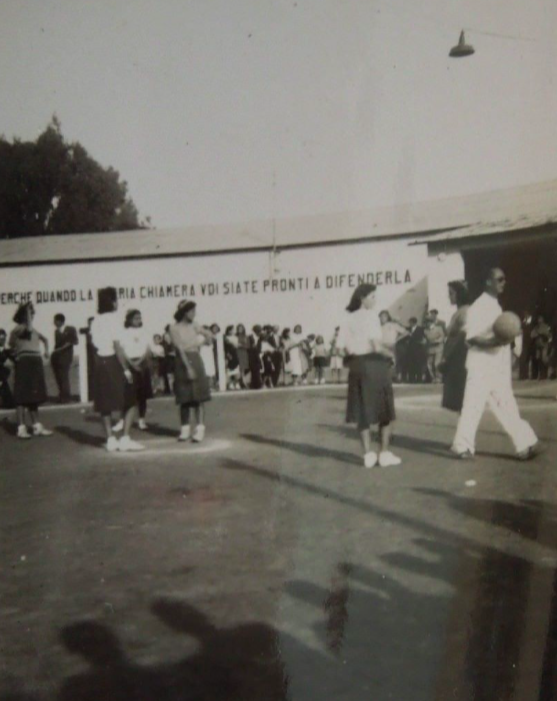
A women’s tournament in Asmara (1939)
Source: https://twitter.com/calciatrici1933/status/1138040625889251328 .
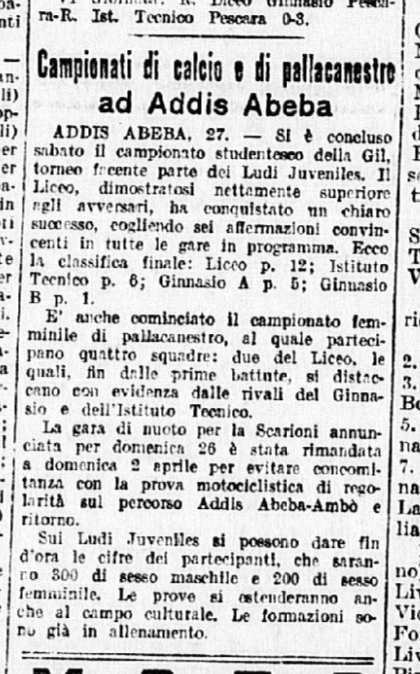
In March 1939, while Italian boys in Addis Abeba (Ethiopia was conquered just three years before) joined a local tournament among the city schools, their female colleagues joined a basket tournament.
The four girls’ teams were: Liceo (Classical High School, 2 teams), Ginnasio (mid-school), and Istituto Tecnico (Tech High School)
Source: La Gazzetta dello Sport, 28/03/1939
Adding to the geographical element, even the number of players involved in the basketball movement supported by the Fascists female youth associations mattered. In 1939 85 teams, coming from 85 different Italian provinces, joined the GIL National championship: even assuming that each team had only 7 players (5 + 2 reserves), we’re talking about 595 girls from all over Italy!
-
In May 1938, 16 women’s teams joined the local tournament by GIL in Rome
As you can see, the local teams recall famous quarters of the Eternal City, such as Parioli, Celio, Esquilino, Parioli, the Trevi Fountain
Source: Il Littoriale, 21/05/1938, p. 3.
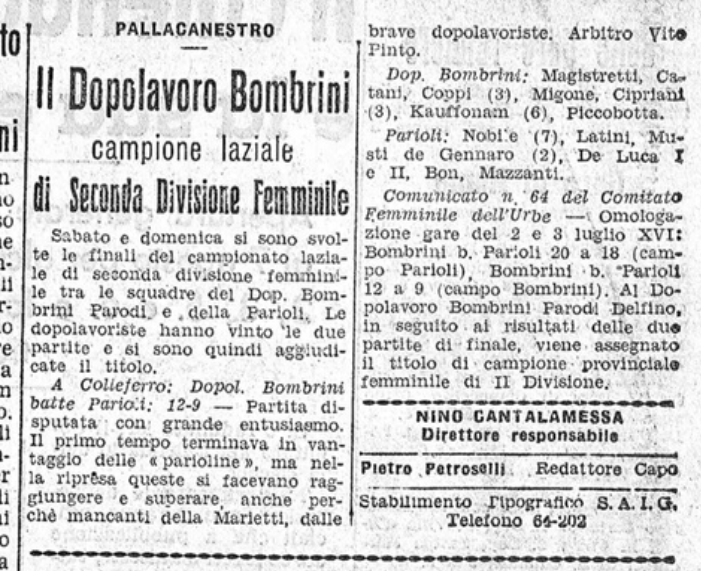
A short article published by nation-wide spread sport newspaper Il Littoriale, about the final match of Seconda Divisione (the third-level championship) championship of Lazio region, between Parioli and Dopolavoro Bombrini
Source: Il Littoriale, 07/07/1938, p. 8.
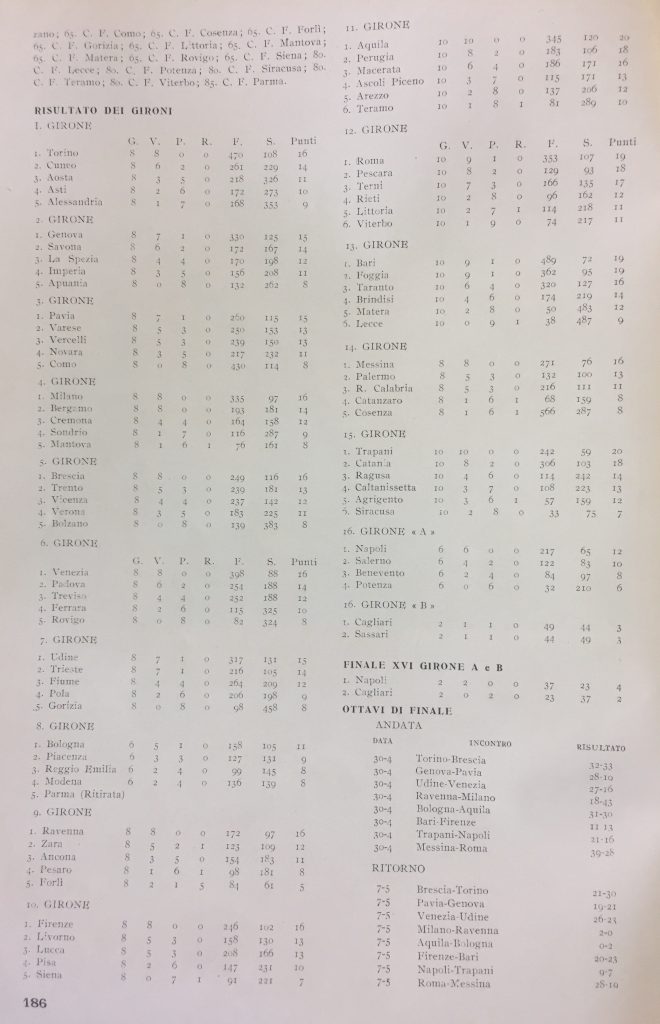
The 1939 GIL National Basketball Championship qualifying round: the 85 teams were distributed onto 17 regional groups
Source: Annuario GIL XVII (1939), p. 186.
Italian press also gave a big push to the women’s basketball movement especially after the first few pioneering years, late Thirties journalists described it as a real sport, and sports newspapers published reports, statistics, photographs, interviews, and insights … in the same way as they did for men’s basketball.

The title of an article about Naples player Anna Ferrari (1935)
Source: Il Littoriale, 20/06/1935, p. 3
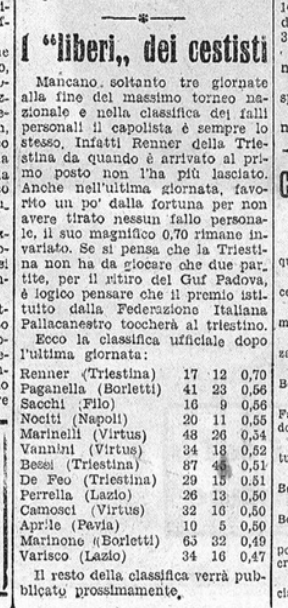
The male best free thrower table (June 1938): Sergio Paganella was first
Source: ll Littoriale, 05/06/1938, p. 2.
-
Three games before the end of 1938 season
Marcella Cacace (Napoli) was ranked 1st as national best free thrower: she was able to overtake Punter (Audax Venezia), who had been top since the beginning of the tournament
Source: Il Littoriale, 28/04/1938, p. 7.
As you can see at 0:31, in 1937 the free thrower was played in a very different way… The game is Parioli vs. OND Bomprini Parodi (13-8), played in Rome for the 4th edition of the Bruno Mussolini Cup (Bruno, the son of Benito, was a big basketball fan). Source: https://youtu.be/tx-da1wiBWI .
Material history could be very useful in studying women’s football during the Fascist Ventennio. The first interesting point is about the courts. As we all know, basketball was invented by James Naismith in 1891 as an indoor game, in order to keep his gym class active on rainy days. Yet in Interwar Italy both men’s and women’s teams played it as an outdoor sport since most of them had no chance to play in a closed gym. For this reason, in the late 1930s, the Italian women’s basketball season generally started in February and ended in June. Journalist sources report that sometimes players had to face strong wind (above all in Trieste and in Dalmatia), rain, and low temperature … Even the material of the basket court could be quite problematic: sometimes it was made of clay (see https://twitter.com/calciatrici1933/status/1363218756827312128 ), or it was just a schoolyard …
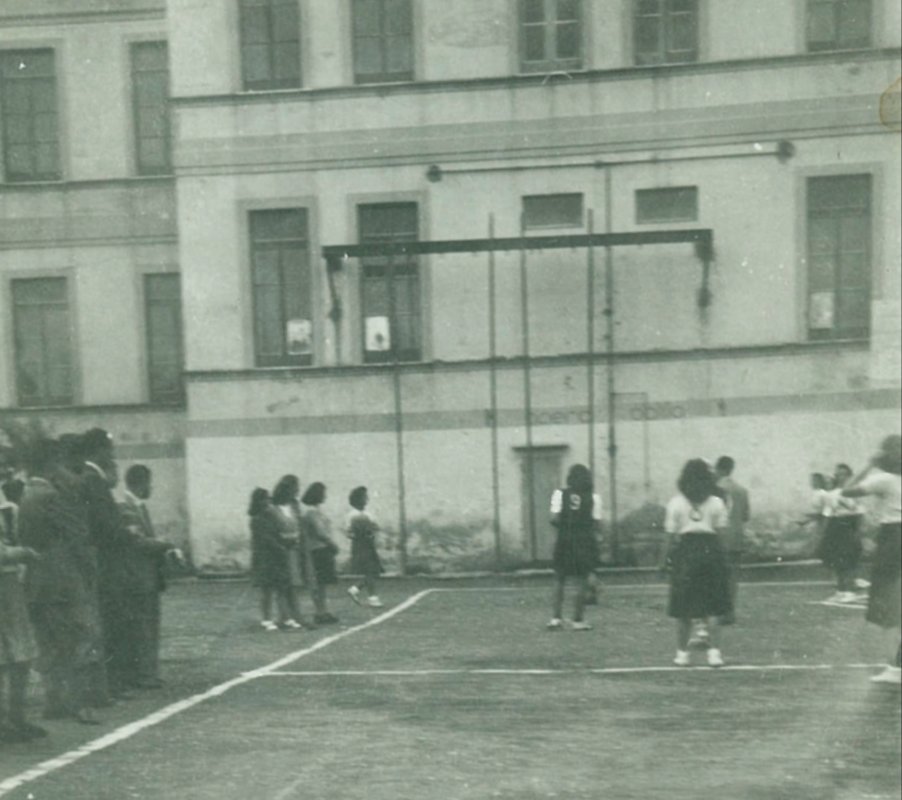
A match played in a schoolyard between GIL Stabia and GIL Ottaviano (1939)
Source: https://bit.ly/2WLB2YD
In 1935, the Parioli team from Rome hosted a double (female and male) match against their French opponents from Nice. As you can see, the outdoor court was very elegant, with wide terraces. Source: https://youtu.be/iGCBATXMNJU .
The brand new basketball court launched in May 1935 at Lungotevere Flaminio, Rome, for the local OND, was different from the roller rink used also by the 2 roller hockey teams: the last had a fence, the first hadn’t, so the players were very close to the audience! Source: https://youtu.be/gNmliIb6BiY
A second material feature is the players’ numbers, worn on the back of their shirts, and in some cases even in the front of them. Starting from mid-Thirties, the first number was 3.
In this 1931 video about a match played in Naples between the local team and Belgian team Williams Elie Club you can see (at 0:49) that the Neapolitan players wears even 1 and 2 numbers over their shirts. As you can see from 0:07, during the Fascist Ventennio «palla al canestro» (or «pallacanestro») was the Italian name of the game, preferred over «basketball» due to nationalistic reason. Source: https://youtu.be/GQ4QTmIiy3U .
Let’s take a look at the team pictures of Ambrosiana Milano, the leading women’s basketball team in the mid-Thirties, as shown by the presence of the little “scudetto” composed by a fascio littorio and the Savoy coat of arms, which was worn by the defending champions.
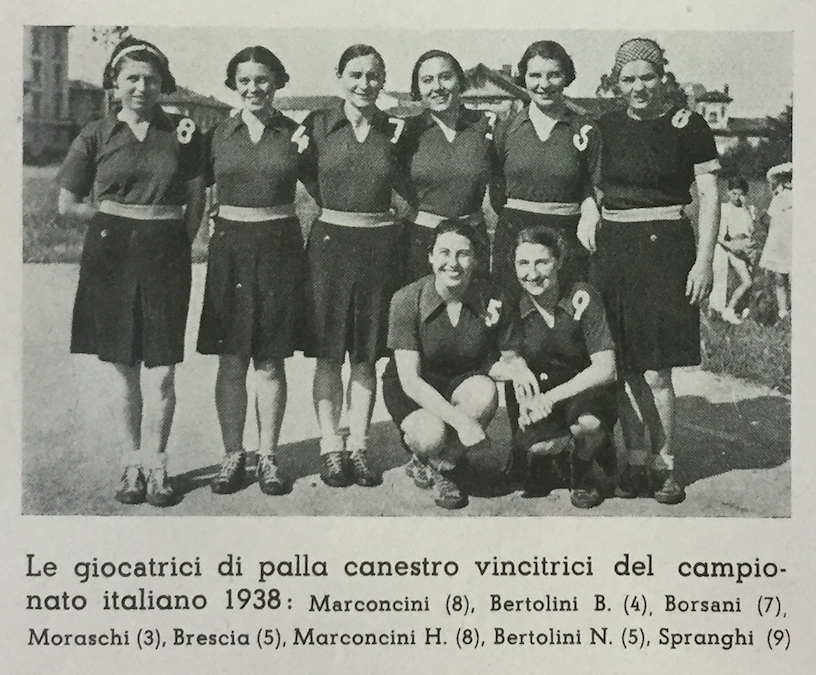
The 1936 Ambrosiana team.
One year previously, these players won the National Championship under the name of Canottieri Milano, but then the rowing society who had hosted them was no longer interested in supporting them
So they turned to Ambrosiana-Inter President Fernando Pozzani … That’s why, although they were all the defending champions, in this photo they’re not wearing the little “scudetto”.
Source: I nerazzurri e i loro cinque scudetti, p. 307.
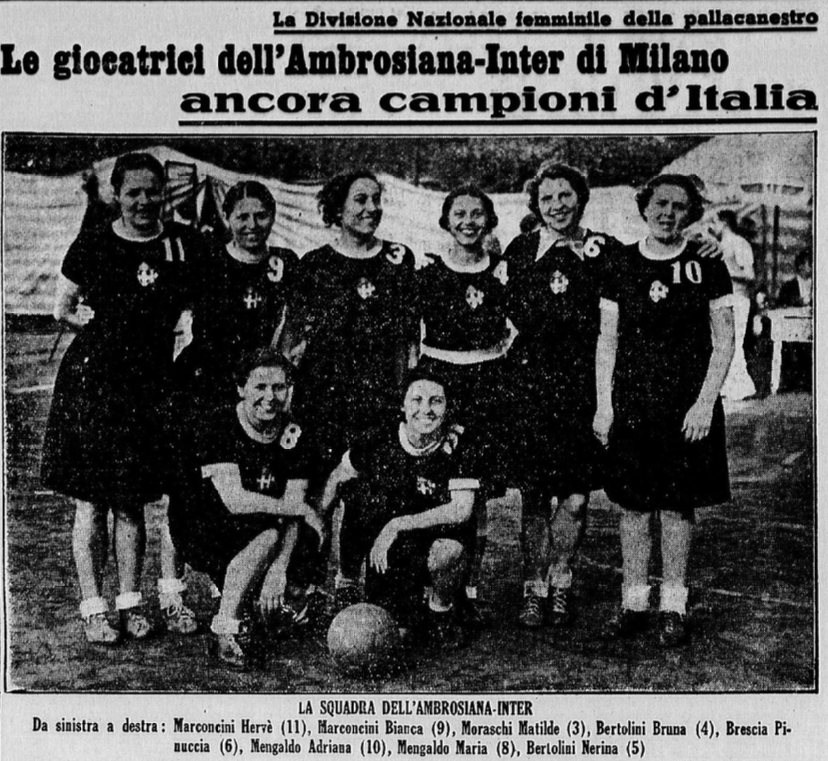
The 1937 Ambrosiana team. Finally, they could wear the “scudetto”, as defending champions
Source: La Gazzetta dello Sport, 08/06/1937, p. 3.
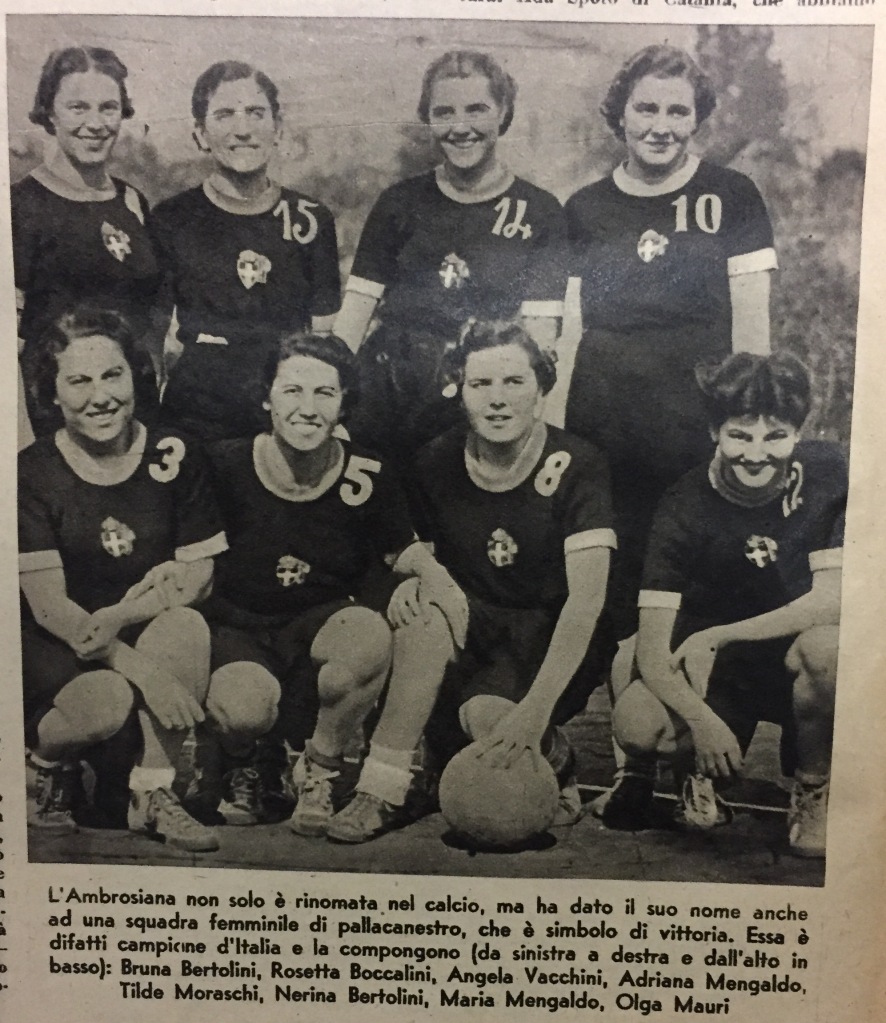
The 1938 Ambrosiana team, that won a further National title
The former GFC football player Rosetta Boccalini joined the team, wearing the number 15 shirt
Source: Donne negli Stadi, Dicembre 1938, p. 20.
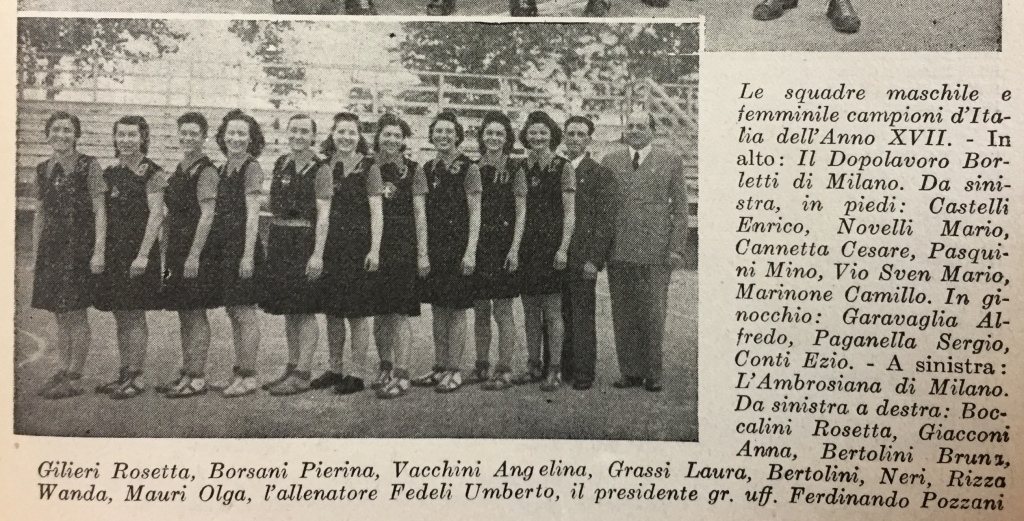
The 1939 Ambrosiana team: as you can see, there were a lot of new players
Source: Annuario della Gazzetta dello Sport, 1940, p. 117.
Looking at these 4 photos with captions, we can reconstruct such a table, very useful in understanding the Ambrosiana line-up changes. In fact, numbers were fixed: except for some rare changes (in blue), the new players (in green) had to take the free numbers, increasing the highest number from 9 (1936) to 15 (1938).
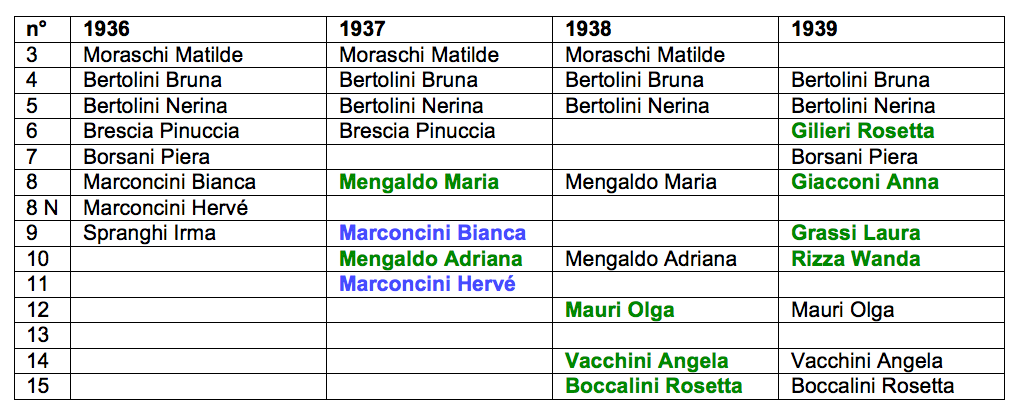
In 1936, the Marconcini sisters were competing for the number 8 shirt: Bianca had the standard one, Hervé a black version of it; the following year (1937), Bianca took number 9, Herveé number 11. When both Mengaldo sisters left Ambrosiana for Giordana Genova (Genua), the young Anna Giacconi and Rizza Wanda could take the number 8 and number 10 shirt they had worn during the past two seasons.
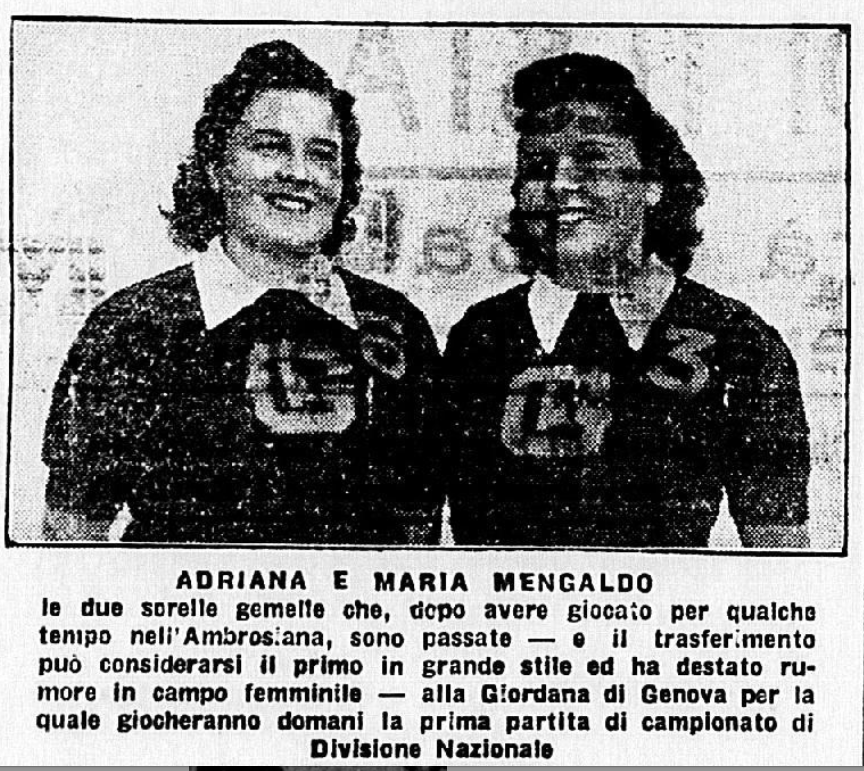
When both Mengaldo sisters left Ambrosiana for Giordana Genova, the Italian press was shocked by the first-ever big player transfer in the history of Italian women’s basketball
One of them also changed the number, taking the number 3 that was already used by Matilde Moraschi in her previous club
Source: La Gazzetta dello Sport, 04/03/1939, p. 2.
This kind of study can be very useful in order to date undated photographs. Let’s look for example at two nice team pictures in the Istituto Luce archives (https://bit.ly/3NgCBHF and https://bit.ly/3Jsv6Lb ), filed as unknown date, unknown place, unknown teams. Comparing the first picture with the 1936 champions’ picture, we can surely state that this is a 1936 Ambrosiana team picture: all numbers even that of Hervé Marconcini match, and Hervé Marconcini wears her number 8 black shirt. Since their opponents, in the second photo, are wearing a <N> shirt, we can imply that the Milanese players were in Naples, for a match with AP Napoli.
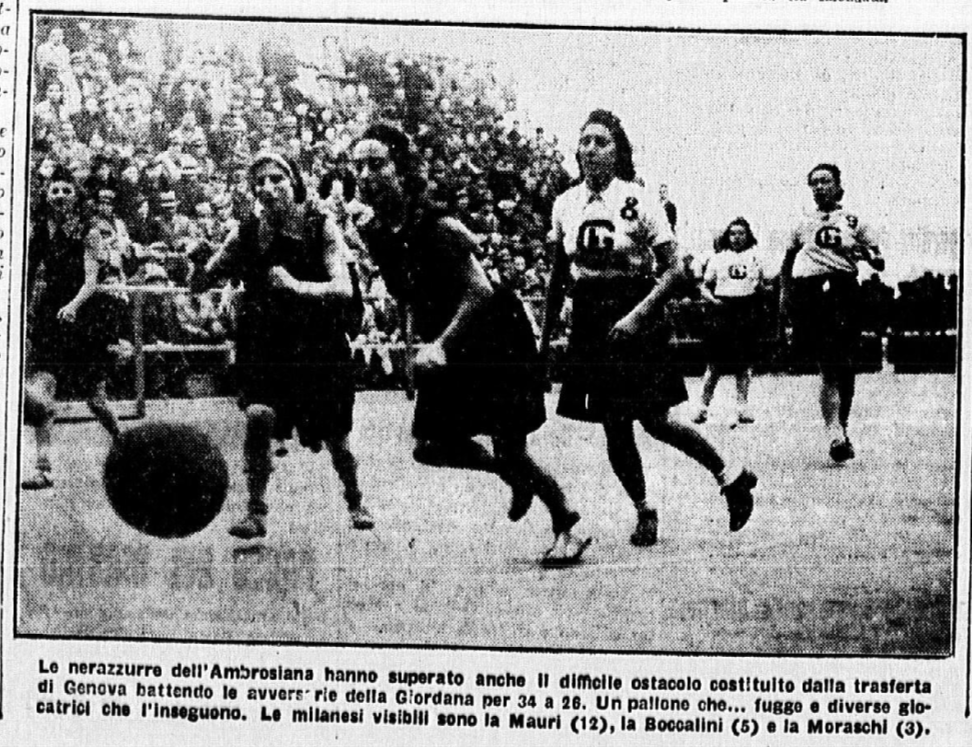
In this caption there is a mistake
Rosetta Boccalini ‘s number was 15, but since ‘1’ is covered by the collar, the editor read it as ‘5’, which was the number always worn by Nerina Bertolini at the time
Source: La Gazzetta dello Sport, 28/03/ 1939, p. 4.
A lot of press editors took little care regarding sportswomen’s photo captions, i. e. publishing old pictures for sports news. In July 1937 the leading monthly Lo Sport Fascista published a nice article by Marina Zanetti (a former basketball player) about the 1937 season, won by Ambrosiana Milano. In the article, Zanetti praises 8 players (Mengaldo sisters, Bertolini sisters, Marconcini sisters, Matilde Moraschi and Pinuccia Brescia), but in the photo (with no caption) we can see 10 players. Who are the other two girls? And above all, are we sure that we’re staring at a 1937 line-up?
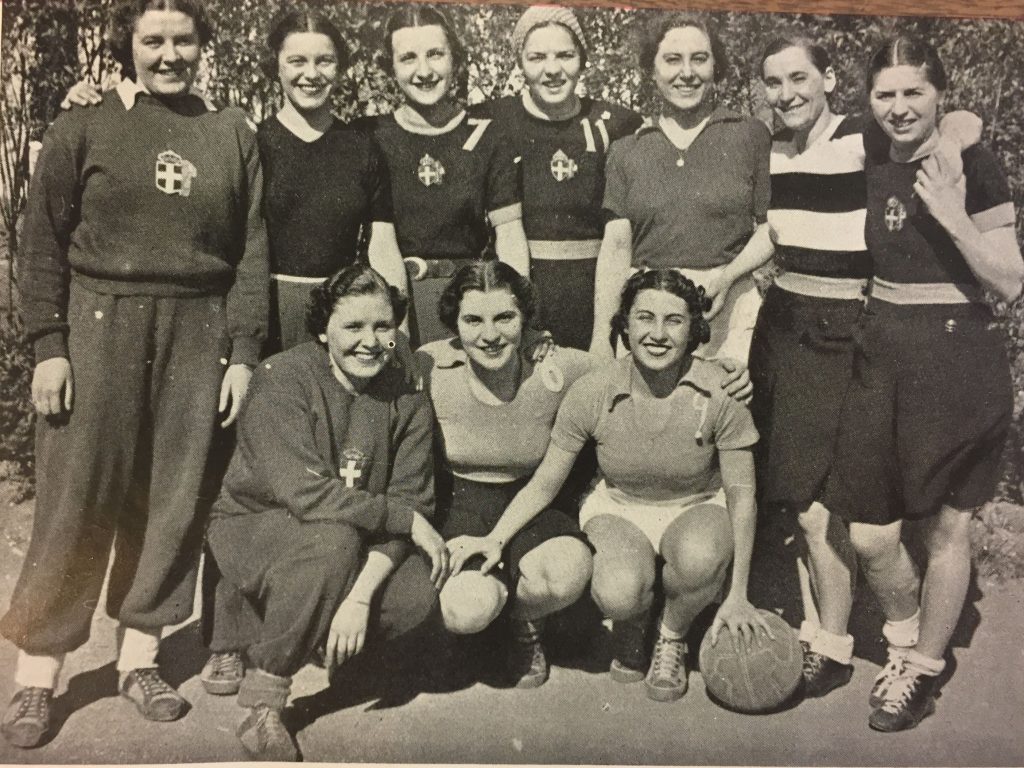
Source: Lo Sport Fascista, July 1937, p. 89
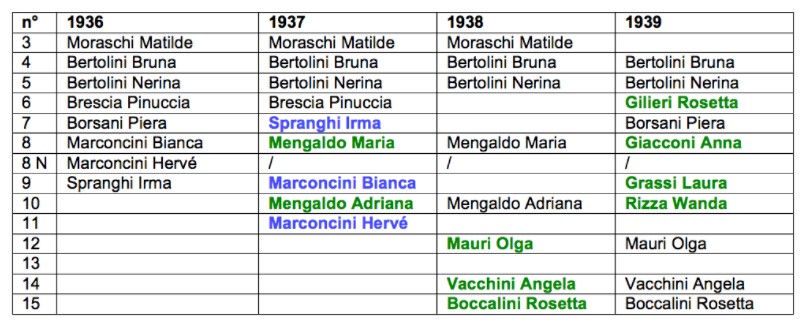
In the following parts of this series, we’re going to talk about some wonderful players’ stories, discovering what they did during World War II and even after 1945, but firstly there is a story to be told.
What happened to the Italian women’s basketball movement in Italian East Africa? After World War II, Italy lost all its colonies. But some went on playing in Eritrea, the former Italian colony occupied by the Allies until 1st of April 1949, when it passed to the British Administration of Eritrea.
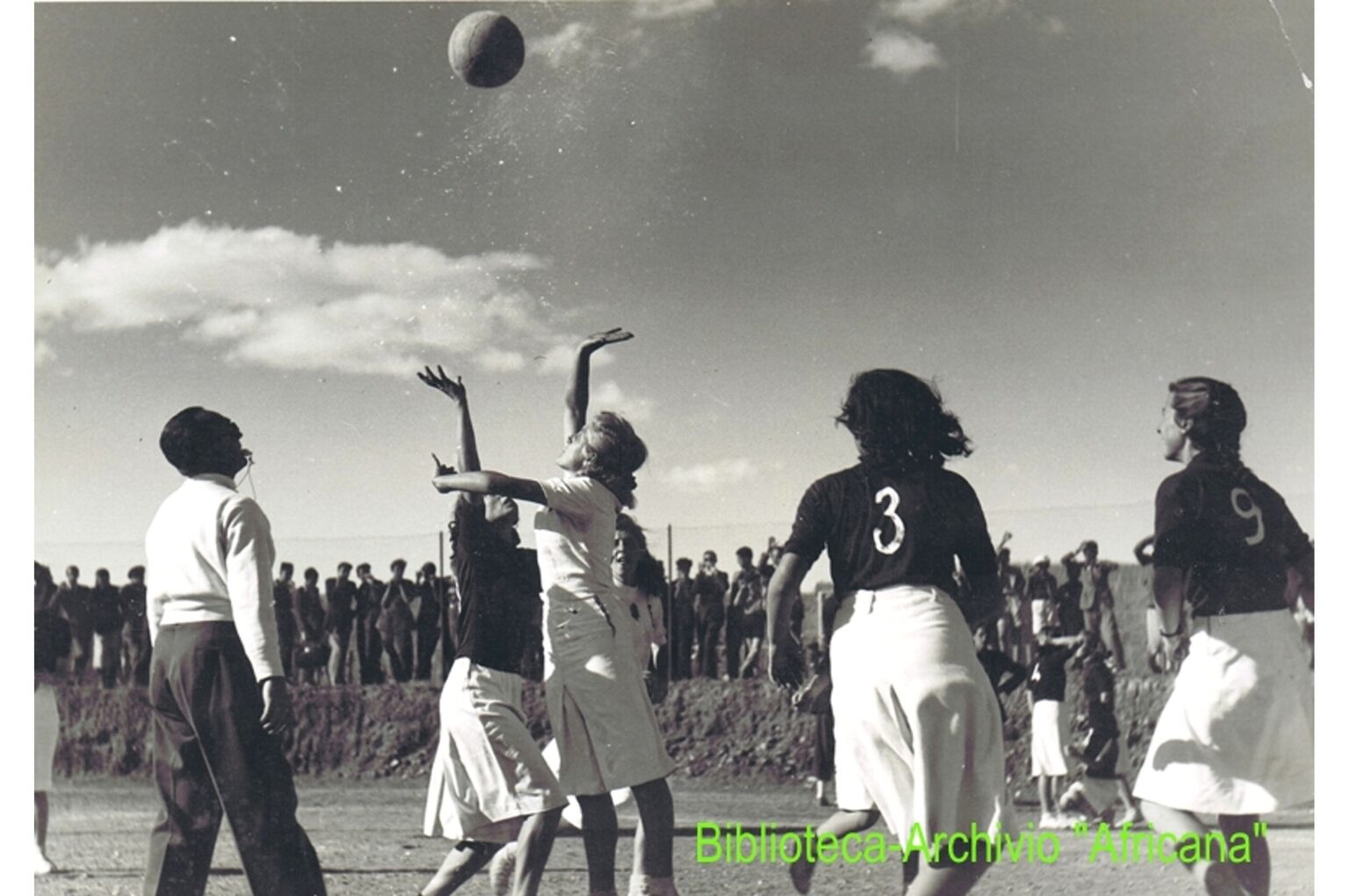
Women playing basketball after WW2 in Eritrea
Source: https://www.ilcornodafrica.it/latletica-tra-gli-italiani-in-eritrea/
In fact, as told in Storie straordinarie (2011) by Nicola Tolomei and Mimmo Cacciuni (pp. 26-27), in 1947 FIP manager and coach Filippo Dragotto was in Asmara. He had reached Italian East Africa in 1936, becoming a POW both in the Second Italo-Ethiopian War and in WWII. Attending a basketball men’s match between a US and an Italian team, he was asked to play as a referee, since in Italy he had been introduced to basketball in the mid-1930s. Then Dragotto asked Sebastiano Bartoli Avveduti, president of the National Italian Olympic Committee (CONI) in Eritrea, to organize basketball matches. In December 1947 Dragotto launched the first edition of Coppa CONI Eritrea, with 4 men’s and 4 women’s teams, and then 2 championships: it was a attracted large audiences.
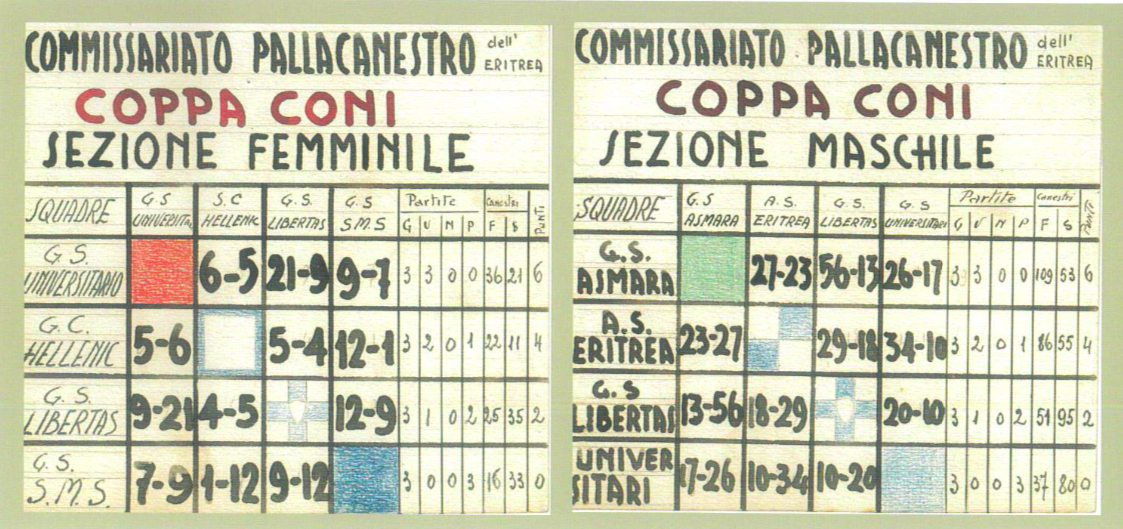
The points of both women’s and men’s team during the Coppa CONI Etiopia (1947-1948)
Note the teams’ names: GS Universitario was the university team, while GS Libertas was probably a Catholic team, since “LIBERTAS” was the slogan upon the coat of arms of the Democrazia Cristiana (DC) party (note also the blue-and-white cross as team’s logo).
According to https://www.ilcornodafrica.it/latletica-tra-gli-italiani-in-eritrea/, ‘SMS’ meant Scuole Medie
Source: Storie straordinarie (http://id.sbn.it/bid/UBO3886245 ), p. 2
After some misunderstanding with the CONI managers, Dragotto resigned: but he didn’t give up basketball. He became coach of two teams (Vigor men’s and women’s team, according to the following photos), and the Catholic Bishop of Asmara asked him to launch the local headquarters of CSI (the Italian Catholic sports association). In December 1949, Dragotto ended his African adventure, coming back to Italy.
Thanks to Mimmo Cacciuni (FIP), we can also look at some photos from 1947/1948 Asmara, previously not published in Storie Straordinarie.
PLEASE NOTE – Express permission is required to reproduce any of these 8 images – please contact Playing Pasts or the author for more details.

A letter form CONI Eritrea President Sebastiano Bartoli Avveduti, written in Asmara on 21/11/1949
He praises Dragotto’s qualities as a coach and as a manager, claiming that basketball could begin again in Eritrea only thanks to him.
During 1949/1950 season, Dragotto was Vigor team coach, and CSI manager
Courtesy of Mimmo Cacciuni (FIP), permision is needed to reproduce this image, please contact Playing Pasts for information

AC Vigor team (Adorati, Mosca, Vazza; Pollera, Melani P.): it was trained by Dragotto
Courtesy of Mimmo Cacciuni (FIP), permision is needed to reproduce this image, please contact Playing Pasts for information
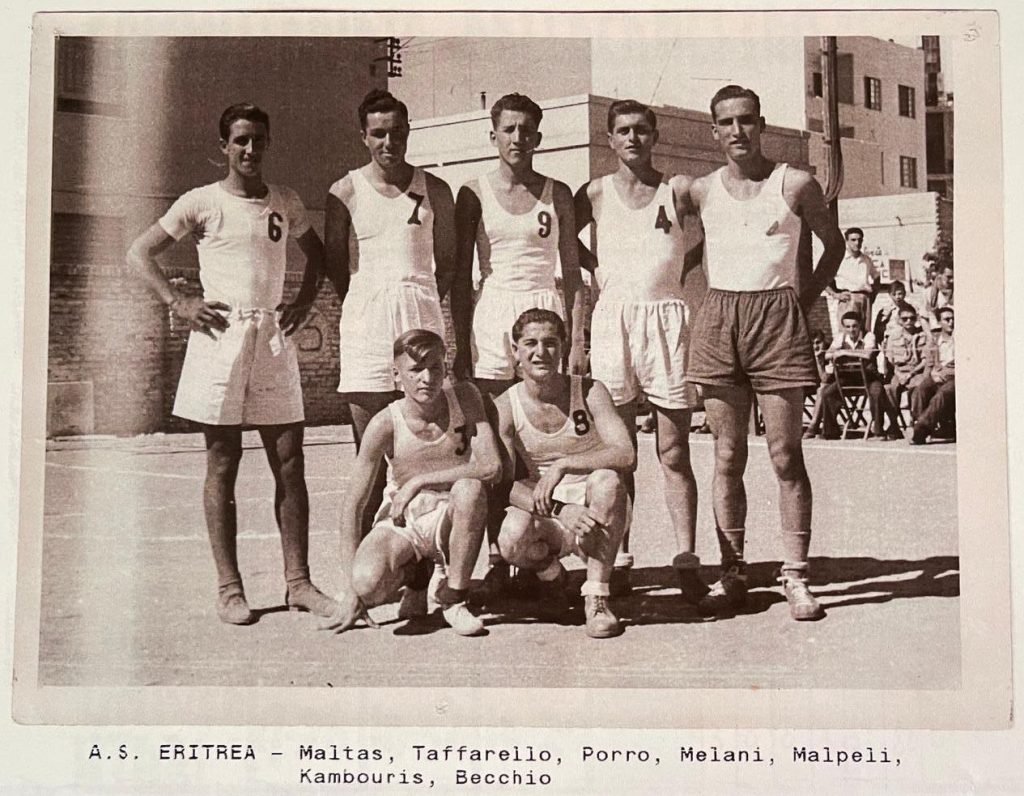
AS Eritrea: Maltas, Taffarello, Porro, Melani, Malpeli; Kambouris, Becchio
According to https://www.ilcornodafrica.it/latletica-tra-gli-italiani-in-eritrea/, Maltas was a Greek citizen
Courtesy of Mimmo Cacciuni (FIP), permision is needed to reproduce this image, please contact Playing Pasts for information
Now come five photos regarding women’s basketball activity.
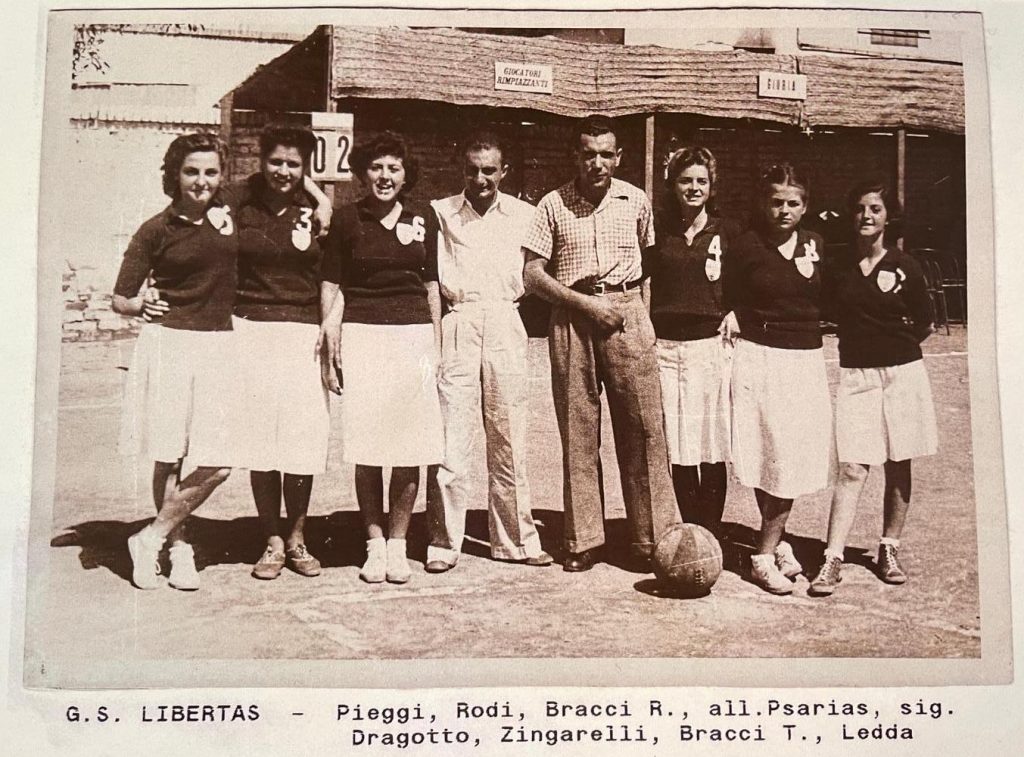
GS Libertas: Pieggi (n. 5), Rodi (n. 3), Bracci R. (n. 6), Psarias (coach), «mr. Dragotto», Zingarelli (n. 4), Bracci T. (n. 8), Ledda (n. 7)
Note the ‘giocatori rimpiazzanti’ (reserves) sign in the background.
Courtesy of Mimmo Cacciuni (FIP), permision is needed to reproduce this image, please contact Playing Pasts for information
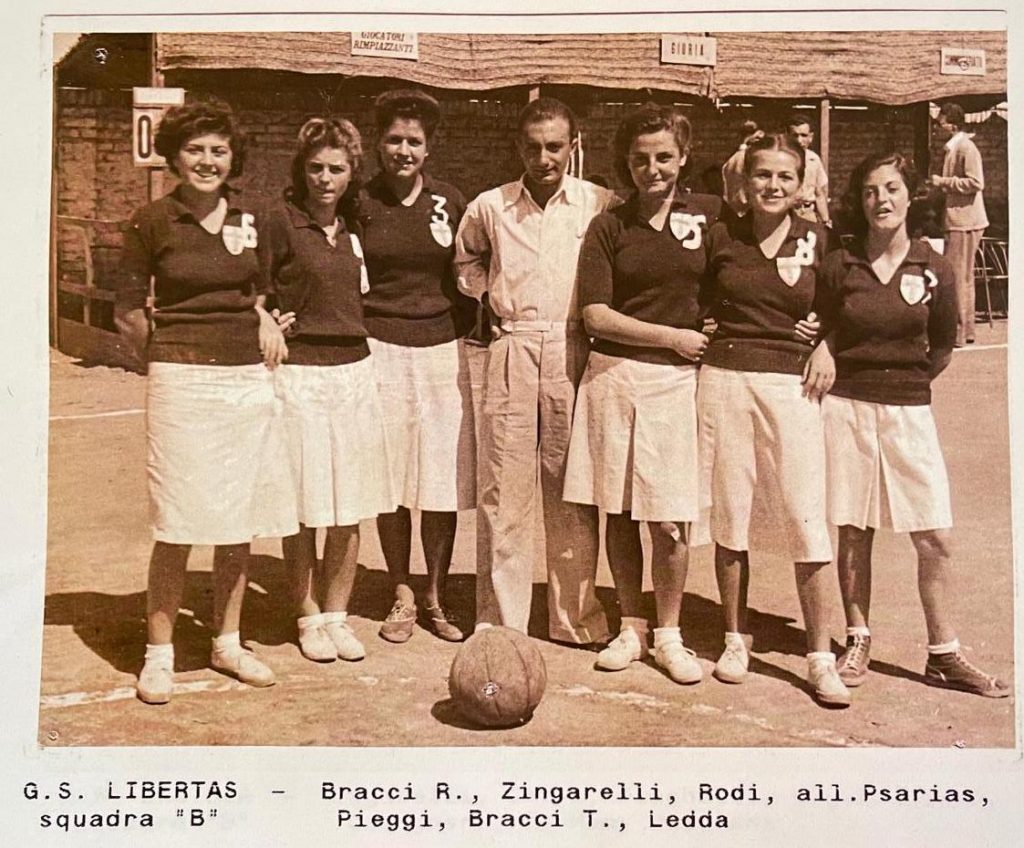
GS Libertas: Bracci R., Zingarelli, Rodi, Psarias (coach), Pieggi, Bracci T., Ledda
The caption says that is a “B team”, but the players’ names and numbers imply that it was just another photo-shoot, taken on the same day and at the same place
Note the cross on the chest of the GS Libertas shirt
Courtesy of Mimmo Cacciuni (FIP), permision is needed to reproduce this image, please contact Playing Pasts for information
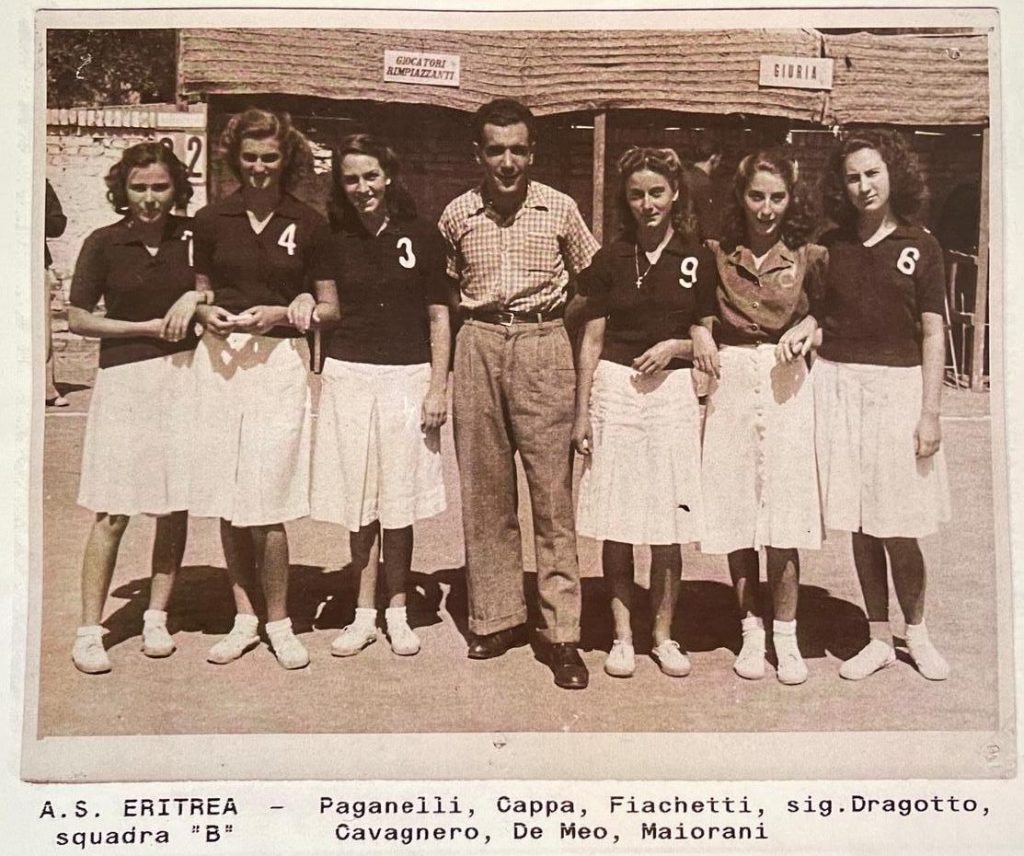
AS Eritrea: Paganelli (n. 7), Cappa (n. 4), Fiachetti (n. 3), «mr. Dragotto», Cavagnero (n. 9), De Meo (n. 8?), Maiorani (n. 6)
Courtesy of Mimmo Cacciuni (FIP), permision is needed to reproduce this image, please contact Playing Pasts for information

Vigor women’s team: Baldini (3), Camisasca C. (8), Bartolini (7), Zingarelli (4), Gerondudi (9); Camisasca A. (6).
Note that Zingarelli kept the same number (4) she had in GS Libertas
Courtesy of Mimmo Cacciuni (FIP), permision is needed to reproduce this image, please contact Playing Pasts for information
The main interesting point of these photos, historically, is that time seems to stop in Fascist Italy. In 1947 Italy players wore shorts: yet in the former colony, female players carried on wearing skirts. Adding to this, we can see only white players, such as happened during Mussolini’s regime, although we can see some native men in the audience. A lot of water still had to flow under the bridge before they would see their daughters play alongside the Italian women.
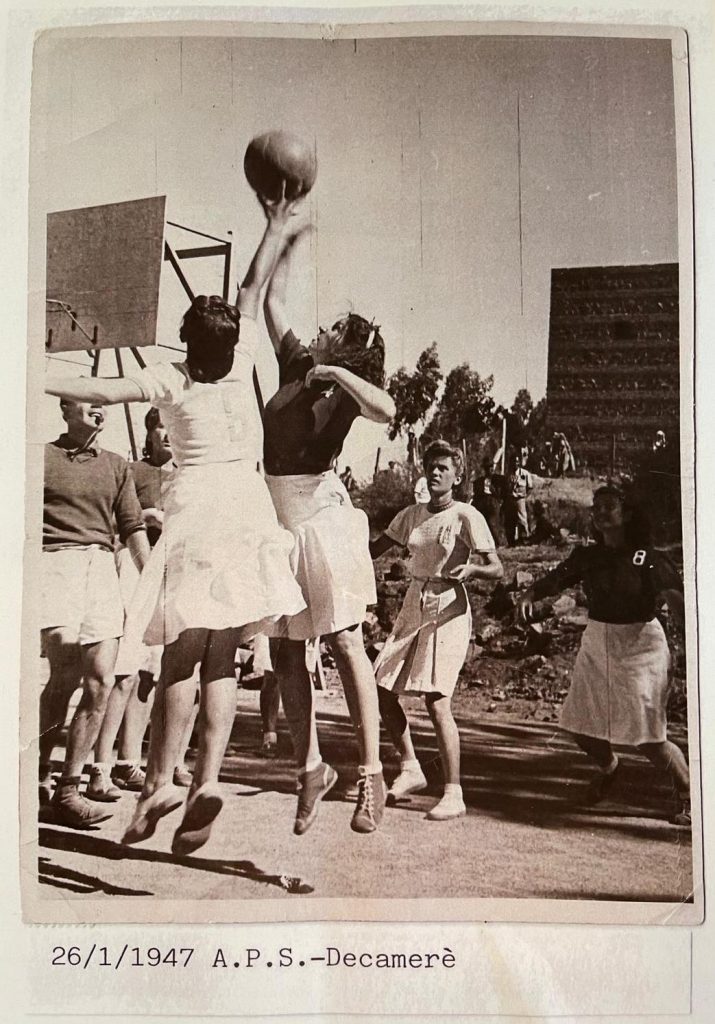
A women’s match (APS – Decamerè) played on 26th January 1947
Courtesy of Mimmo Cacciuni (FIP), permision is needed to reproduce this image, please contact Playing Pasts for information
Article © of Marco Giani
To read Part 2 Click HERE
For more images about women’s basketball in Interwar Italy, see:
https://twitter.com/calciatrici1933/status/1072141225946480640
For a gallery about the Ambrosiana players, see:
https://sorelleboccalini.wordpress.com/extra_sport_la-galleria-delle-cestiste-dellambrosiana/
For more images about women’s sport in Italian colonies, see:
https://twitter.com/calciatrici1933/status/1085965110944899075

